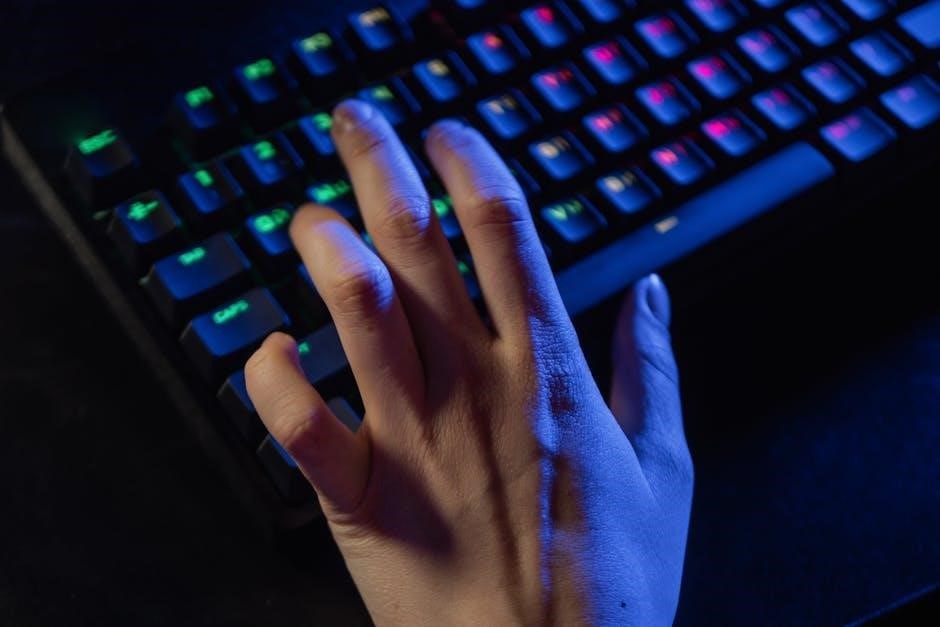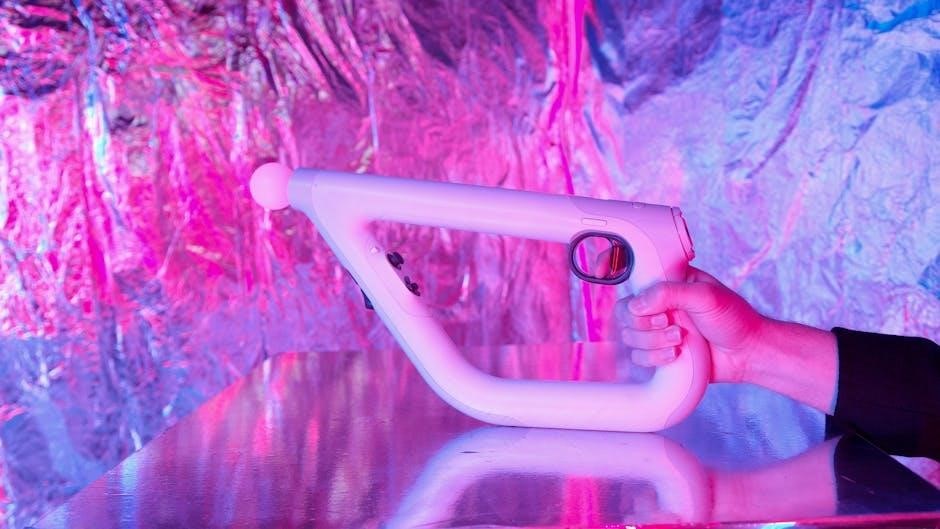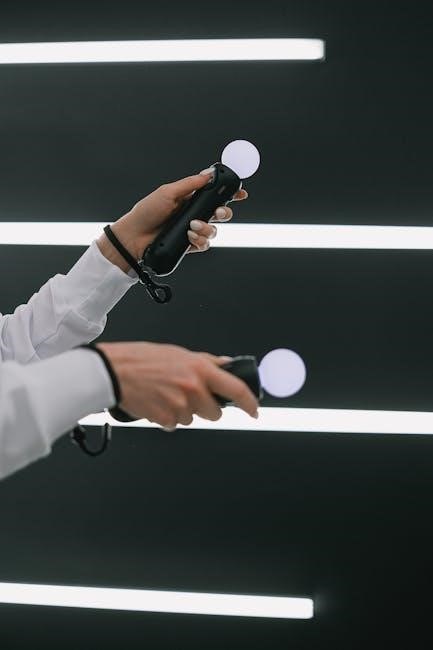Learn how to operate your LED strip lighting system using a remote control; This guide covers setup, basic functions, and advanced features for seamless control.
1.1. What You Need to Get Started
To begin, ensure you have the LED strip, remote control, receiver/controller, and power supply. Verify compatibility between components. Use double-sided tape for installation. Read safety instructions and manufacturer guidelines before proceeding. Ensure the power supply matches the LED strip’s voltage requirements. Keep the remote control batteries installed. Familiarize yourself with the remote’s buttons and functions. Proper preparation ensures smooth setup and operation of your LED strip system.
1.2. Understanding the Components: LED Strip, Controller, and Remote
The LED strip is the flexible lighting component with RGB or single-color LEDs. The controller/receiver connects to the strip and power supply, managing brightness and color. The remote sends IR signals to the controller, enabling adjustments. Ensure compatibility between components for proper functionality. Understanding each part’s role ensures seamless operation and customization of your lighting setup. Proper connections and signal transmission are key to controlling the LED strip effectively. Familiarize yourself with these components to maximize your system’s potential.
Installing the LED Strip and Controller
Mount the LED strip in your desired location, ensuring secure adhesion. Connect the strip to the controller/receiver box, then plug in the power supply. Test the connection.
2.1. Connecting the LED Strip to the Controller/Receiver Box
Align the LED strip’s connector with the controller’s input port, ensuring proper alignment of the pins. Gently plug in the strip, securing it firmly. For non-plug-in strips, solder the positive (+) and negative (-) wires to the corresponding terminals on the controller. Double-check the polarity to avoid damage. If using an RGB strip, match the color-coded wires to the controller’s inputs. Once connected, ensure the strip lies flat and the wires are secure. Plug in the power supply to test the connection.
2.2. Powering the System: Plugging in the Controller and Power Supply
First, connect the power supply to the controller using the provided cable. Ensure the power supply matches the LED strip’s voltage (12V or 24V). Plug the power supply into a nearby electrical outlet. Turn on the power supply and check for any indicator lights on the controller to confirm power is on. Avoid overloading the outlet and ensure all connections are secure. If using a receiver, plug it in after connecting to the controller for proper synchronization.

Pairing the Remote Control with the Receiver
Press the sync button on the receiver while pointing the remote at it; Ensure the receiver is powered on and follow the LED indicator for confirmation.
3.1. Syncing the Remote Control with the Receiver
To sync the remote with the receiver, ensure both devices are powered on. Locate the sync button on the receiver, typically marked or near the LED indicator. Press and hold this button until the LED starts flashing, indicating pairing mode. Next, point the remote control at the receiver and press the sync or learn button on the remote. Hold it for a few seconds until the LED on the receiver stops flashing, confirming successful pairing. This process ensures seamless communication between the remote and receiver, allowing you to control your LED strip effortlessly.
3.2. Testing the Remote Control Functionality
After syncing, test the remote control by pressing buttons to ensure proper functionality. Start by turning the LED strip on and off using the power button. Adjust brightness levels and verify color changes to confirm responsiveness. Check if all buttons, including dimming, color selection, and effects, work correctly. If any function fails, re-sync the remote with the receiver. Test the remote from different angles and distances to ensure reliable connectivity. Proper functionality ensures a seamless user experience and confirms successful setup.
Basic Remote Control Functions
Master essential controls: switch the LED strip on/off using the power button, adjust brightness levels with up/down arrows, and change colors or modes with designated keys.
4.1. Switching the LED Strip On/Off
To turn the LED strip on or off, locate the power button on the remote, typically labeled or colored distinctly. Press once to power on and again to turn off. Ensure the remote is pointed directly at the receiver for reliable signal transmission. Some remotes may have a red button for this function. Always confirm the strip’s power status by checking its illumination after pressing the button. This basic operation ensures easy control of your lighting setup.
4.2. Adjusting Brightness and Color Settings
Use the remote’s buttons to adjust brightness by pressing the increase or decrease buttons. For color settings, press the color change button to cycle through options or use directional buttons for precise selection. Some remotes allow pressing and holding to transition smoothly between colors. Ensure the remote is aimed at the receiver for consistent control. Adjustments are reflected instantly, enabling you to customize the lighting to your preference. Experiment with different combinations to achieve the perfect ambiance for any setting.

Advanced Features of the Remote Control
Explore timer settings, dimming options, and color-changing effects. Use the remote to schedule lighting, adjust brightness, and sync colors for dynamic displays, enhancing your LED strip experience.
5.1. Color Changing and RGB Effects
Control vibrant color transitions and dynamic RGB effects with ease. Use the remote to cycle through preset colors, create custom hues, or activate patterns like flashing and fading. For seamless color synchronization, ensure the LED strip is properly connected to the controller. Press the color change button to switch between red, green, and blue, or mix them to achieve unique shades. Experiment with speed adjustments for smooth transitions, enhancing your lighting experience with endless creative possibilities.
5.2. Setting Timer and Dimming Options
Enhance your lighting experience by setting timers and adjusting dimming levels. Use the remote to program timers for automatic on/off functionality, ensuring your LED strip operates effortlessly. Adjust brightness levels with the dimming buttons, creating the perfect ambiance for any setting; For timer setup, press and hold the timer button until the desired duration appears. Dimming can be fine-tuned incrementally or maximized with a single press. These features offer convenience and customization, allowing you to tailor your lighting to suit your preferences effortlessly.

Troubleshooting Common Issues
Identify and resolve common issues such as connectivity problems, power supply faults, and remote synchronization errors. Check connections, ensure proper power supply, and restart the system if necessary. Refer to specific subsections for detailed solutions.
6.1. LED Strip Not Responding to Remote Commands
If your LED strip isn’t responding to remote commands, first ensure all connections between the strip, controller, and power supply are secure. Verify that the remote has batteries and is within range. Check for any obstructions blocking the infrared signal. Restart the system by unplugging and replugging the power supply. If issues persist, attempt pairing the remote with the controller again by pressing the sync button on the controller while pointing the remote at it; Ensure no interference from other devices. If problems continue, refer to the user manual or contact support for further assistance.
6.2. Power Supply and Connection Problems
Power supply issues can cause LED strips to malfunction. Ensure the power adapter is correctly plugged into both the controller and a working outlet. Verify the voltage matches the strip’s requirements, typically 12V or 24V. Check connections between the strip and controller for damage or loose wires. Avoid using low-quality or incompatible power supplies, as they may overheat or fail. If the issue persists, test the power supply with another device to confirm functionality. Consult the user manual or contact a professional if problems remain unresolved.

Safety Precautions and Instructions
Always handle LED strips and controllers with care to avoid damage. Ensure proper installation to prevent electrical hazards. Keep components away from water and extreme temperatures.
7.1. Handling the LED Strip and Controller Safely
Always handle the LED strip and controller with care to avoid damage. Avoid bending the LED strip excessively, as this may cause damage to the circuitry. Keep the components away from water and moisture to prevent electrical hazards. Use the correct power supply to avoid overheating, and ensure all connections are secure. Never touch electrical parts with wet hands. IMPORTANT: Store the remote control and receiver in a dry, cool place to maintain functionality. Regularly inspect the LED strip for signs of wear or damage before use.
7.2. Avoiding Common Mistakes During Installation
Avoid common mistakes during installation to ensure proper functionality. First, ensure the LED strip is connected securely to the controller to prevent signal loss. Double-check the power supply voltage matches the LED strip’s requirements. Do not overload the controller with too many strips, as this can cause overheating. Additionally, avoid placing the receiver in areas with obstructions, as this may interfere with remote control signals. Always follow the manufacturer’s guidelines for installation to minimize errors and ensure optimal performance of your LED lighting system. Proper setup is key to longevity and efficiency.
Regularly maintain your LED strip and remote system for optimal performance. Explore additional features and customizations to enhance your lighting experience. Always follow safety guidelines for longevity.
8.1. Maintaining Your LED Strip and Remote Control System
Regularly clean the LED strip to ensure optimal light output. Check connections and replace worn-out cables. Update remote control batteries and avoid exposing components to moisture. Proper care extends lifespan and performance.
8.2. Exploring Additional Features and Customizations
Discover advanced capabilities like RGB color cycling, timer settings, and dimming effects. Experiment with preset modes or create custom lighting scenes. Update firmware for new features and ensure compatibility. Use the remote to save favorite settings for easy access. Explore syncing multiple strips or integrating with smart home systems for enhanced control. Refer to the user manual for specific customization options and unlock the full potential of your LED strip system.


